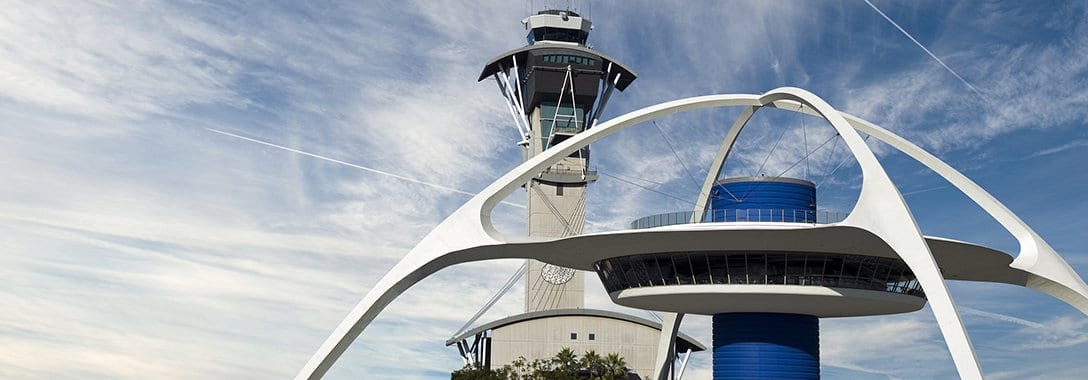The Freight Forwarder’s Guide to LAX

If you are an importer who regularly brings goods in through the Los Angeles/Long Beach ports, you may have used air freight services through Los Angeles International Airport, better known as LAX.
LAX is a hub for domestic and international transportation. The number of people that arrive and depart from LAX daily makes it the second-busiest airport in the United States, and the fourth busiest worldwide. Nearly 2.2 million tons of cargo go through LAX each year, ranking it No. 5 in cargo processed through United States ports. Worldwide, it ranks No. 14.
How did it become such a hub and what impact has that had in the Southern California region? Here is what you should know about LAX.
The History of LAX
Long before the building of LAX, the location was known as Bennett Rancho. The land was used to grow wheat, lima beans, and barley. However, the rise of aviation in the 1900s changed its function. Early pilots used the area to land their planes, but it was not until 1927 when local citizens and the city of Los Angeles considered making it an airport. A real estate agent named William W. Mines offered 640 acres of Bennett Rancho to Los Angeles for use as an airport. This area was named Mines Field, and it was where he built the first airport.
This first airport was far from the LAX we know today. In the beginning, the airport was for general use, but the US Air Force used it for military flights during World War II. After the war, in 1946, it officially became Los Angeles Airport, with the “International” added in 1950.
LAX Cargo-Related Statistics
- LAX has 194 acres dedicated to freight services and facilities.
- LAX has 30 cargo-only airlines that operate at the airport.
- LAX’s top air freight imports include computers, cell and landline phones and parts, computer chips, and unmounted diamonds.
- There are 300 freight forwarders and 350 customs brokers in the Southern California area to help ship air cargo around the world.
- In 2015, LAX handled cargo valued at $101.4 billion.
- LAX’s largest trading partner is China.
LAX Today
LAX is located 18 miles from Downtown Los Angeles, covering 3,425 acres of land. It is owned and operated by a proprietary department of the city of Los Angeles, known as Los Angeles World Airports (LAWA). When LAX first opened, it served five major airline carriers, American, Trans World, United, Western, and Pan Am. That has now expanded to 66 airline carriers that make use of its nine terminals and four runways.
LAX’s Cargo Facilities
There are 30 cargo-only airlines operating out of LAX, with 194 acres dedicated specifically for cargo use. There are some cargo handling facilities and warehouses owned and operated by the airport, as well as airlines and non-airline companies. LAX has two main freight facilities that airlines rent, including the Century Cargo Complex and the Imperial Cargo Center.
Since LAX is a hub for international freight forwarding and travel, U.S. Customs works closely with the airport to screen both cargo and passengers. Their headquarters location is east of LAX.
The Freight Forwarders and Customs Brokers of LAX
There are nearly 300 freight forwarders and 350 customs brokers that serve in the Los Angeles and Long Beach area. They work with importers and exporters to clear customs and coordinate air freight forwarding services. They also can arrange for goods to be shipped out from the seaports or via rail and truck services to other parts of the United States.
The Los Angeles Customs Brokers & Freight Forwarders Association promotes the industry in the area and provides training for customs brokers and regular workshops about customs policies and procedures.
LAX’s Importance to the Region and Country
As both a travel and trade hub, LAX supports more than 600,000 local jobs and creates $126.6 billion in revenue. One in 20 jobs in Southern California is related to LAX, according to AirportLA. Altogether, LAX generates $15 billion in local, state and federal taxes.
LAX supports 322,000 trade-related jobs. In 2015, $101.4 billion of cargo was handled through the airport. China is LAX’s largest trading partner, with cargo valued at $25.5 billion.
LAX’s top imports include computers, cell and landline phones and parts, computer chips, and unmounted diamonds. The top exports out of LAX are civilian aircraft parts and engines; unmounted diamonds; cellular and landline phones and parts, gold and computer chips.
The Future of LAX
There are plenty of changes coming to LAX, including a new airport terminal scheduled to open in 2019. Overall, LAX is spending nearly $1.9 billion to upgrade terminals, add taxiways and ramps, and connect light rail service to the airport. All of this is to help meet the growing number of travelers going in and out of LAX year over year.
While there haven’t been any major announcements for air freight forwarding or cargo facility upgrades, experts in the industry know that many of the cargo-service facilities need modernization. There also needs to be more focus on reducing traffic congestion and better coordination for goods moving off airport grounds. More and more, LAX is coordinating with the ocean Port of Los Angeles to help address these issues.
Whatever changes are to come, LAX will remain a major global hub of trade for years to come.

